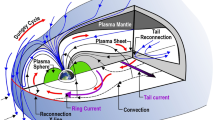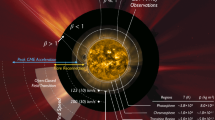Abstract
We analyzed the features of the longitudinal distribution of the areas of solar spots during the solar activity minima, from the 11th cycle to the last minimum, based on data provided by the Greenwich Observatory and the Marshall Research Center. We discovered that the solar spots evolved in one or two neighboring bands (in terms of longitude), the Carrington longitude of which smoothly displaced from the east to the west, in the phase of the deep minimum in all of the considered cases. The spots at the high latitudes associated with a “new” cycle evolved on the same longitude bands. All of this led to the noticeable longitudinal asymmetry of magnetic fluxes related to the spots and flocculi. Based on our research, we propose the hypothesis that a nonaxisymmetric component of the total magnetic flux of the Sun is generated, together with the dipole component, by the solar dynamo mechanism, which is a typical feature of the phase of a minimum between the solar activity cycles.
Similar content being viewed by others
References
Benevolenskaya, E.E. and Kosovichev, A.G., Variations in the structure and rotation of the convective zone with the cycle phase and their relation with the dynamics of magnetic fields, Izv. RAN, Ser. Fiz., 2006, vol. 70, no. 10, pp. 1413–1416.
Benevolenskaya, E.E. and Ponyavin, Yu.D., Synoptic magnetic field in cycle 23 and in the beginning of the cycle 24, Adv. Space Res., 2012, vol. 50, no. 6, 656–661.
Benevolenskaya, E.E. and Kostuchenko, I.G., The total solar irradiance, UV emission and magnetic flux during the last solar cycle minimum, J. Astrophys., 2013, vol. 2013, pp. 1–9.
Dikpati, M. and Gilman, P.A., A shallow-water theory for the Sun’s active longitudes, Astrophys. J., 2005, vol. 635, no. 2, pp. L193–L196.
Gilman, P.A. and Fox, P.A., Joint instability of latitudinal differential rotation and toroidal magnetic fields below the solar convection zone, Astrophys. J., 1997, vol. 484, no. 1, pp. 439–454.
Golovko, A.A. and Salakhutdinova, I.I., Fractal properties of active regions, Astron. Zh., vol. 89, no. 6, pp. 458–464.
Ivanov, E.V., Active longitudes: Dynamics, rotation, and origin, Izv. RAN, Ser. Fiz., 2006, vol. 70, no. 10, pp. 1417–1422.
Kostuchenko, I.G. and Benevolenskaya, E.E., Active longitudes in minima of solar activity, Geomagn. Aeron. (Engl. Transl.), 2014, vol. 54, no. 8, pp. 1019–1025.
Mordvinov, V.I., Devyatova, E.V., and Tomozov, V.M., Hydrodynamic instabilities in tachocline caused by variations in the sheet thickness and inhomogeneities in the median flux, Soln.-Zemnaya Fiz., 2013, no. 23, pp. 3–12.
Norton, A.A. and Gilman, P.A., Recovering solar toroidal field dynamics from sunspot location patterns, Astrophys. J., 2005, vol. 630, pp. 1194–1205.
Vitinskij, Yu.I., Longitudinal distribution of active regions and solar cycles, Byull. Soln. Dannye Akad. Nauk SSSR, 1986, no. 2, pp. 67–72.
Author information
Authors and Affiliations
Corresponding authors
Rights and permissions
About this article
Cite this article
Kostuchenko, I.G., Benevolenskaya, E.E. The features of longitudinal distribution of solar spots during the last 13 solar activity minima. Geomagn. Aeron. 55, 1039–1044 (2015). https://doi.org/10.1134/S0016793215080162
Received:
Accepted:
Published:
Issue Date:
DOI: https://doi.org/10.1134/S0016793215080162




